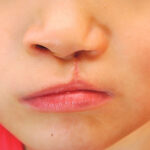Explore This Issue
March 2023Cleft Lip and Palate Incidence Remains Steady
 Cleft lip and palate are the most common birth defects of craniofacial development, with up to 7,000 children in the United States born with the condition annually (Front Pediatr. 2013. doi:10.3389/fped.2013.00053). Cleft lips are more common, occurring in one in 500 to 600 babies born, whereas 1 in 1,000 live births have a cleft palate that is inside the mouth and not visible from the outside, according to Dr. Tollefson.
Cleft lip and palate are the most common birth defects of craniofacial development, with up to 7,000 children in the United States born with the condition annually (Front Pediatr. 2013. doi:10.3389/fped.2013.00053). Cleft lips are more common, occurring in one in 500 to 600 babies born, whereas 1 in 1,000 live births have a cleft palate that is inside the mouth and not visible from the outside, according to Dr. Tollefson.
The incidence of cleft lip and palate has remained steady over the years. Certain factors are known to contribute to their development, such as smoking and taking the epilepsy medications topiramate and valproic acid during the first trimester of pregnancy. Rare syndromes such as Van der Woude syndrome also are associated with the condition. Many women may even be unaware that they are pregnant at the time clefts develop, which occurs at four to six weeks in utero for cleft lip and eight to 12 weeks for cleft palate, respectively, according to Dr. Hetzler.
While taking folic acid during pregnancy is recognized to help reduce risk, other causes and prevention methods of the condition are unknown. “There are fetal surgeries under investigation for spina bifida during which the surgeon and team operate while the fetus is in the womb and is still attached to the umbilical cord, but cleft lip and palate is not life threatening, and fetal surgery has significant risks,” Dr. Tollefson said. “Instead, advances will occur in fine tuning the protocols that are used to treat these kids.”